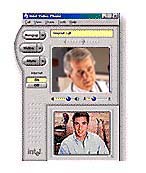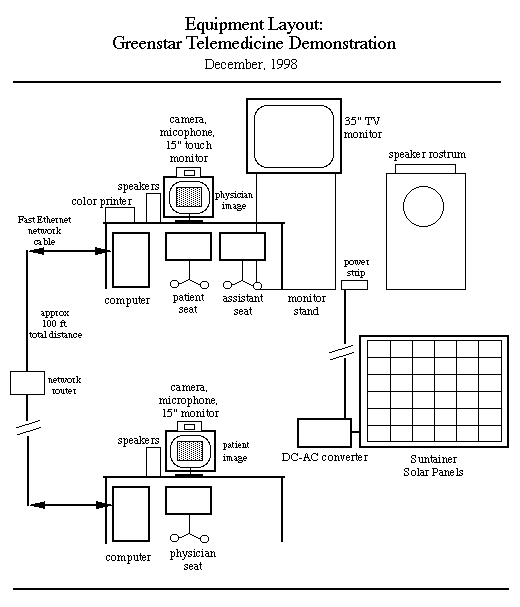
Telemedicine
sample script and specifications for
a demonstration of simple
medical diagnosis and treatment
using live two-way video on a computer network
This HTML document is also available
for download in Acrobat (PDF) format; click
here to download.
If you don't have Acrobat Reader installed on your system, get
it for free at http://www.adobe.com
Please email comments to Michael
North.
Purpose:
To show, in a vivid and easily-understood way, how advanced technology
can serve a vital human need: making direct, personal medical
diagnosis and treatment available to anyone, anywhere.
Audience:
The general public; technical and medical authorities; diplomats
and government representatives; the press and electronic media.
Basic Description:
A two-way live video conference over a local network is held
between a patient and a doctor, discussing a simple medical condition
of tendonitis; the patient receives diagnosis, treatment, prescription
and followup.
Benefits:
People who will benefit from telemedicine include many around
the world who do not have direct access to mainstream medicine.
These include many people in small communities which have no
regular source of electrical power or medical resources.
Medical facilities, clinics and hospitals benefit from having
access to specialists, records and research available worldwide,
broadening their resources to serve their patients.
Future Application:
Given a high-speed connection to the Internet, the consultation
described below could take place today between a doctor and patient
at any two points in the world without changing any hardware
or software from that demonstrated. Such high-speed connections
are now widely available through digital cellular networks, through
cable and fiber, and soon through low-cost satellite networks
worldwide.
This telemedicine conferencing system will be available as
part of the Greenstar system, entirely powered by clean, renewable
solar energy.
Resources:
Two high-speed computers, connected to each over a local network,
with video conferencing software and hardware; solar panels to
power one of the workstations; engineers and technicians to set
up and support the equipment; a large-screen video system showing
the live interaction; explanatory literature and press releases;
detailed timed script
Remarks:
This demonstration will show the general public and the press
one of the most simple applications of telemedicine: a remote
consultation between physician and patient.
In addition, a substantial database about other, more complex
telemedicine applications, databases, imaging, artificial intelligence
diagnostics, patient records and payment systems, etc. will be
available on the touchscreen and online on the Web for professionals
and technical press to examine.
The entire diagnostic dialog, and the screens which drive
it, will be thoroughly edited and approved by top medical authorities
for simplicity, clarity and medical accuracy. This program is
not an attempt to reproduce any specific current professional
telemedicine system; it is intended to provide a description,
in principle, of how such systems operate and to communicate
their significance to people's basic needs -- quickly, simply
and in a universally-accessible way.
Interaction Summary:
After introductory remarks, the sample patient is seated at a
touchscreen system; it shows a cycling series of graphics about
medical care. The patient touches the screen, and immediately
the image of a Palestinian doctor appears; the patient begins
speaking to the doctor.
 The doctor is seated at a similar
workstation in another room in the conference facility, up to
200 ft. away. His workstation has two-way video and audio connected
to the patient; they can see and hear each other on a large,
color image comparable in quality to standard video, and can
thus interact naturally.
The doctor is seated at a similar
workstation in another room in the conference facility, up to
200 ft. away. His workstation has two-way video and audio connected
to the patient; they can see and hear each other on a large,
color image comparable in quality to standard video, and can
thus interact naturally.
The screen shows both people in adjacent windows simultaneously.
See the demonstration image at left.
The patient describes soreness, stiffness and pain in his
wrist, and the doctor asks him questions about when it started,
what kind of exertion he's been having, his history of similar
pain, etc. He asks the patient to flex his hand and describe
where the pain is.
The doctor diagnoses possible tendonitis, prescribes a pain
medication and bracing bandage; he electronically sends a sample
prescription, with details about exercise and other things he
can do on his own; he copies the patient's physician by e-mail,
and schedules a followup consultation in the future.
This one-page referral appears on the screen after their conversation
is over, and is immediately printed on a color printer , and
the patient is given a copy.
The presentation ends, with comments and questions from technical
and medical representatives. Written briefing materials describe
the system in detail, how and where it can be implemented
Script:
Introductory remarks: Greenstar telemedicine spokesman;
the need for medical care in remote communities
Introductory remarks: Medical consulting spokesman;
the significance of telemedicine, bringing advanced technology
to people in the cause of advancing peace and humanitarian aid;
description of demo to come
Demonstration: the patient sits at the touchscreen
workstation, accompanied by technical assistant
First screen: telemedicine theme screen, with animated
graphic; the patient touches to begin
Second screen: A live doctor appears in a window on-screen,
greets the patient, asks diagnostic questions, gets the patient
to flex hand for him, move it, to describe the pain and when
it occurs; doctor watches movement of the hand and makes possible
tendonitis diagnosis.
He writes a prescription for painkiller and tendon relaxant
(this is all pre-scripted), describes necessary bracing bandage
and orders it.
Doctor sends sends email to a prescription center ordering
medication (prescription dosage of acetaminophen); sends email
to the patient's physician informing him of the treatment orders;
describes that the patient should do on his own (rest, elevation,
warm compresses) then makes appointment for followup in two weeks;
all the materials are pre-scripted, so this happens quickly.
While this is taking place, people on the scene can see what
the patient is seeing, both on the touchscreen itself and on
a large projection screen or monitor, in a dual-image display
fed directly from the touchscreen behind the computer.
Third screen: An email of the prescription, a calendar
of the appointment, and a copy of the email to patient's physician
all appear on the patient' screen; he touches the Print button
on the screen and the material is printed; he takes it, touches
screen once more; consultation ends and returns to theme screen
Concluding Statements, Q&A
Timeline:
Assuming the demonstration event takes place at 1:00 pm. local
time, here is a sample timeline:
Introductory Remarks:
Greenstar spokesman: 1:00 - 1:05 pm.
Introductory Remarks:
Medical introduction, description: 1:05 - 1:10 pm.
Screens 1 and 2 (see above):
Prescription, followup dialog: 1:10 - 1:18 pm.
Concluding Statement
Summary of the message 1:18 - 1:20 pm.; plus Q&A time

Technical Description:
Two Pentium II Hewlett-Packard 6370Z computers, 350 Mhz, 96
Mbytes RAM, 10 Gbyte disk, SVGA video, Windows 98; 100BaseT Fast
Ethernet adapters; speakers
One computer (for the patient) has a MicroTouch 15" touch
display, running Prospector Web-access touchscreen software and
a color inkjet printer; the other (for the doctor) has a standard
15" color monitor, running video conferencing
Both computers have Intel ProShare video conferencing hardware
and software, including camera, microphone
100BaseT insulated Ethernet cable, connected with a simple Ethernet
hub, runs between the two workstations, delivering a high-speed
link (150 Mbps) sufficient to support a 320x200 full-color video
window, 30 frames-per-second, with concurrent audio; the two
workstations may be 200 ft. apart
All major components are from U.S. manufacturers
A large NTSC video monitor (35") or rear-screen SVGA video
projector (52") displays the image the patient sees on his
touchscreen for onlookers, press. The computer used has both
composite and RGB video out available; the press may access a
live feed of the images for recording.
|
 a demonstration of simple medical diagnosis and treatment using live two-way video on a computer network
If you don't have Acrobat Reader installed on your system, get it for free at http://www.adobe.com Please email comments to Michael North.
Purpose: Audience: Basic Description: Medical facilities, clinics and hospitals benefit from having access to specialists, records and research available worldwide, broadening their resources to serve their patients. Future Application: This telemedicine conferencing system will be available as part of the Greenstar system, entirely powered by clean, renewable solar energy. Resources: Remarks: In addition, a substantial database about other, more complex telemedicine applications, databases, imaging, artificial intelligence diagnostics, patient records and payment systems, etc. will be available on the touchscreen and online on the Web for professionals and technical press to examine. The entire diagnostic dialog, and the screens which drive it, will be thoroughly edited and approved by top medical authorities for simplicity, clarity and medical accuracy. This program is not an attempt to reproduce any specific current professional telemedicine system; it is intended to provide a description, in principle, of how such systems operate and to communicate their significance to people's basic needs -- quickly, simply and in a universally-accessible way. Interaction Summary:
The screen shows both people in adjacent windows simultaneously. See the demonstration image at left. The patient describes soreness, stiffness and pain in his wrist, and the doctor asks him questions about when it started, what kind of exertion he's been having, his history of similar pain, etc. He asks the patient to flex his hand and describe where the pain is. The doctor diagnoses possible tendonitis, prescribes a pain medication and bracing bandage; he electronically sends a sample prescription, with details about exercise and other things he can do on his own; he copies the patient's physician by e-mail, and schedules a followup consultation in the future. This one-page referral appears on the screen after their conversation is over, and is immediately printed on a color printer , and the patient is given a copy. The presentation ends, with comments and questions from technical and medical representatives. Written briefing materials describe the system in detail, how and where it can be implemented Script: Introductory remarks: Greenstar telemedicine spokesman; the need for medical care in remote communities Introductory remarks: Medical consulting spokesman; the significance of telemedicine, bringing advanced technology to people in the cause of advancing peace and humanitarian aid; description of demo to come Demonstration: the patient sits at the touchscreen workstation, accompanied by technical assistant First screen: telemedicine theme screen, with animated graphic; the patient touches to begin Second screen: A live doctor appears in a window on-screen, greets the patient, asks diagnostic questions, gets the patient to flex hand for him, move it, to describe the pain and when it occurs; doctor watches movement of the hand and makes possible tendonitis diagnosis. He writes a prescription for painkiller and tendon relaxant (this is all pre-scripted), describes necessary bracing bandage and orders it. Doctor sends sends email to a prescription center ordering medication (prescription dosage of acetaminophen); sends email to the patient's physician informing him of the treatment orders; describes that the patient should do on his own (rest, elevation, warm compresses) then makes appointment for followup in two weeks; all the materials are pre-scripted, so this happens quickly. While this is taking place, people on the scene can see what the patient is seeing, both on the touchscreen itself and on a large projection screen or monitor, in a dual-image display fed directly from the touchscreen behind the computer. Third screen: An email of the prescription, a calendar of the appointment, and a copy of the email to patient's physician all appear on the patient' screen; he touches the Print button on the screen and the material is printed; he takes it, touches screen once more; consultation ends and returns to theme screen Concluding Statements, Q&A Timeline: Assuming the demonstration event takes place at 1:00 pm. local time, here is a sample timeline: Introductory Remarks:
 Technical Description: Two Pentium II Hewlett-Packard 6370Z computers, 350 Mhz, 96
Mbytes RAM, 10 Gbyte disk, SVGA video, Windows 98; 100BaseT Fast
Ethernet adapters; speakers
|